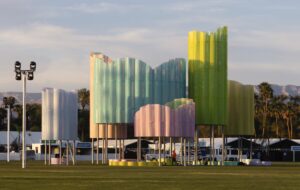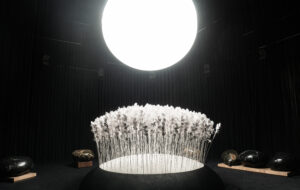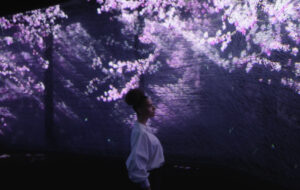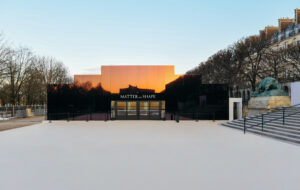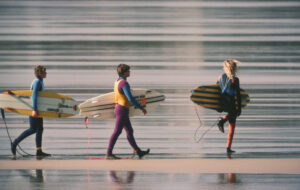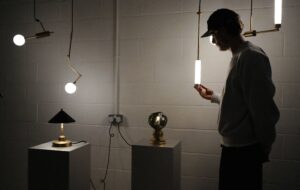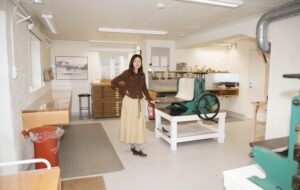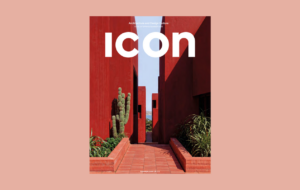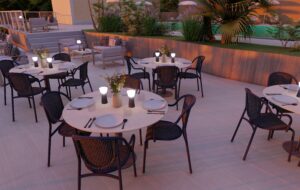|
Paolo Soleri went from Frank Lloyd Wright disciple to desert prophet, founding his own urban community in the Arizona scrub. This strange, half-realised utopia captures the narcissism of the lone visionary architect – and reminds us why, sometimes, we need them It can’t be easy funding utopia with bells. But that’s what they’ve been trying to do at Arcosanti since 1970. The date gives a clue. Arcosanti is one of those visionary utopias thrown up in the desert in the Age of Aquarius. An eccentric stack of strange structures, it looks somewhere between the archaeological artefacts of a lost civilisation and the ruins of a lost future. It is the fruit of the barely-covered loins of Paolo Soleri, one of 20th-century architecture’s weirdest, most charismatic and least clothed architects. Soleri was born in Turin in 1919 to a father whose company made ceramic electrical components. The young Paolo was a phenomenal draftsman who went to study architecture but had his studies curtailed by the war, finally graduating in 1946 when he won a scholarship to study with Frank Lloyd Wright at Taliesin West, the self-proclaimed greatest living architect’s Arizona winter base. All the students there paid their way, working on the construction of the settlement as they drew up Wright’s buildings. Soleri, unable to contribute any extra, was confined to working in the kitchens when he wasn’t pouring concrete. A year and a half later he stormed out in disgust, having gained a deep respect for Wright’s work and a profound distaste for his ideas. Wright at this time was working on Broadacre City, the epitome of US sprawl, a straggling version of the American dream in which every suburbanite had an acre and a bungalow and a car the size of a battleship. With his Mediterranean background and delight in company, Soleri pined for a more intense urbanity. Running against the stream of both mainstream urbanism (still in thrall to the car) and hippy culture (Soleri was hardworking and demanding, no dropping out here), the architect envisioned a dense, futuristic city getting its power from the sun and combining industry and residential and communal functions in a multi-level, environmentally low-impact and self-sustaining community. First he designed a house on a hill not far from Taliesin, a semi-submerged, sun-worshipper’s cavern with a spiralling, retractable glass roof. Then he retuned to Italy and built a remarkable ceramics factory (1950–60) in the south, a porto-eco industrial plant with wavy walls like those of Eladio Dieste and a kind of expressionist, spiralling interior. He also built himself a remarkable-looking house cantilevered from the rocks on the coast, which was destroyed by a landslide, prompting his return to the States. The first incarnation of his urban ideas, that anti-Broadacre intensity, can be seen at Cosanti, which he established outside Phoenix, Arizona, in 1956 and where he lived until his death in 2013. This agglomerative landscape resembles something between sci-fi and pre-history, a weird desert settlement that seems to invoke everything from the Flintstones and the Wombles and Gaudí to Star Wars and 1970s brutalism. There is nothing quite like it. The name derives from a mash-up of ‘cosa’ (Italian for ‘things’ or ‘matter’) and ‘anti’ – as in ‘against’. It is both antimatter and anti-materialist, a diametric opposite to Wright’s sprawl and American mid-century consumerism. Yet Soleri was not quite a part of the cooperative, communitarian spirit of the 1960s. At Cosanti everybody worked and everybody worked together, but there was no pooling of individual resources. Instead Soleri was (as Wright had been before him) tight-fisted, narcissistic and egocentric. He would work semi-naked, wearing only a pair of the briefest of briefs or, occasionally, a kind of loin-cloth (which added to the Planet of the Apes aesthetic of the place). He was a notorious flirt and, in the more constrained atmosphere of the era, I’m uncertain how much further that might have gone. His parsimony, however, led to a settlement that was never as good as it could have been (he used sub-standard materials and scraped the bottom of the barrel, or at least the concrete mixer) and the narcissism meant that, again like Wright, too much depended on one man. Nevertheless, what Soleri set in motion in Cosanti was something utterly unique and, in 1970, it spawned an even bigger experiment, Arcosanti – its moniker intended to embody Soleri’s concept of ‘Arcology’, this time a cocktail of ‘ecology’ and ‘architecture’. For my generation of architects, Arcosanti was one of those odd, distant experiments one kept coming across in academic libraries stocked in the 1970s – when universities had money – yet, only a decade later, it seemed archaic and utterly anachronistic. Soleri seemed to us almost as distant as Wright. Yet to encounter these spaces is to be seduced, enthralled, appalled and, occasionally, thrilled by the mad ambition of it all. A model at the current (and excellent) Soleri exhibition at the Scottsdale Museum of Contemporary Art outlines the visionary intent behind Arcosanti. We see a few fragments, like the crumbly, dusty archaeological remains of a cult temple precinct. The model, a massive acrylic stack, reveals Soleri’s insane ambition to create a kind of space station in the desert – a futuristic, standalone and self-contained city, its huge towers acting as legs rather than spires and interconnected in a maze of complex bridges, ramps and staggered terraces. It is spacecraft, oil platform, off-world colony and metabolist megastructure combined. It is, also, nothing like what you actually perceive on site, with its terrible concrete and shabby, ad hoc construction. But its failure is inscribed precisely in that model. It is present in the dirt that the curators never managed to scrub out – this was a model stored outside since it was constructed by female, student, unpaid labourers who never finished their work. It is a perfect metaphor for a failed but brilliant idea. But it is not, by any means, all there was. Even a cursory look around the show reveals something entirely different. When not constrained by the difficulty and expense of actual construction, Soleri’s architecture was magical and anticipated, I’d suggest, much of what has come since. An astonishing, red-hued drawing of a bridge from 1977 looks like a UFO floating above a Martian landscape. Yet it exemplifies Soleri’s attitude to the earth, the idea that the ground should be as little disturbed as possible, and the bridge presented the perfect paradigm – a symbolic connection, inhabited and touching the earth only delicately at its ends, suspended and exquisite. He was, like so many others before him, a little obsessed with Florence’s Ponte Vecchio. Another drawing from 20 years earlier shows an art nouveau-inflected structure, the complex concrete construction of which echoes the work of the Italian postwar expressionists (notably Giovanni Michelucci) but also presages Saarinen’s TWA Terminal at JFK and, I’d suggest, the work of Zaha Hadid and the parametricists. And Zaha, it transpires, really did go to see Soleri lecture at the AA in the 1970s when the hard-up Arizona architect toured the world to garner fees for the continued construction of his settlements (apparently he used to get the costs for business class tickets and hire a car instead, pocketing the difference). Another design for an airport with its tendrils and organic interconnections resembles an underwater organism rendered as a terracotta ornament by Louis Sullivan – weird, beautiful and almost unsettling in the way that HR Giger’s dark, organic sci-fi could be simultaneously seductive and repellant. Other drawings (and that vast model) reveal Soleri to be very much a man of his time. Older than the young punks of Archigram and around the same age as the Japanese metabolists, the desire is there to create metropolitan mountains, complex, self-sufficient systems that appear to protect their inhabitants from looming environmental catastrophe or treat the desert like another planet, something to be revered, respected and isolated. They are rich with the kind of greebling that production designers add to tiny models or renderings to make the miniature look vast – think of the Death Star or Star Destroyer in Star Wars or the Tyrell Corporation in Blade Runner, both being designed at the same time as Soleri was building. Steven Spielberg was, incidentally, born around the corner in Scottsdale. You also can’t help thinking that George Lucas must surely have encountered Arcosanti when he was planning Tatooine in Star Wars in the mid-1970s, when Soleri’s sandy city was in its most vigorous stage of construction. But as well as the sci-fi strangeness of the vision, there are other things going on out here in the desert. At times you see a vault built around a tree or concrete growing out of sheer bedrock – moments of absolute architectural drama in which all of Soleri’s ideas about architecture and landscape, as well as his debt to Wright, come gushing into clear view. At other points – in the huge circular windows, the concrete-encased stairs and dramatic interiors – there are hints of Louis Kahn. There are public places and auditoria that feel genuinely urban. In the strange, abstract-patterned vaults there are bits of Wifredo Lam or Picasso. These are in-situ concrete panels in which the earth they were cast from was tinted with natural pigments so that the reliefs pick up those colours in the final version. The pattern is not applied, it is integral. And then there are those infernal bells in bronze, aluminium and ceramics. Soleri’s bells, which are still being cast and sold in the shop and across the world, are, essentially, the chief funding source for the ongoing construction of the two settlements. Their cast-in patterns, their strange shapes and those bow-tie chain links make these compositions of chimes distinctive and a little naff. There is something simultaneously suburban, bohemian and fabulously dated about them. Yet they sell. Perhaps because, on visiting these two places, people get a little infected by the message, the failed utopia, the desert mirage, the DIY paradise. Whatever it is, something about Soleri still fascinates. Perhaps he is the archetypal architect, working for himself, never needing to bend to clients’ demands, the lone visionary. Perhaps he was what |
Words Edwin Heathcote
Photography Andrew Moore
Soleri is the illustration of why we need clients, neighbours, planners and others to keep our insane ambitions in check |
|


